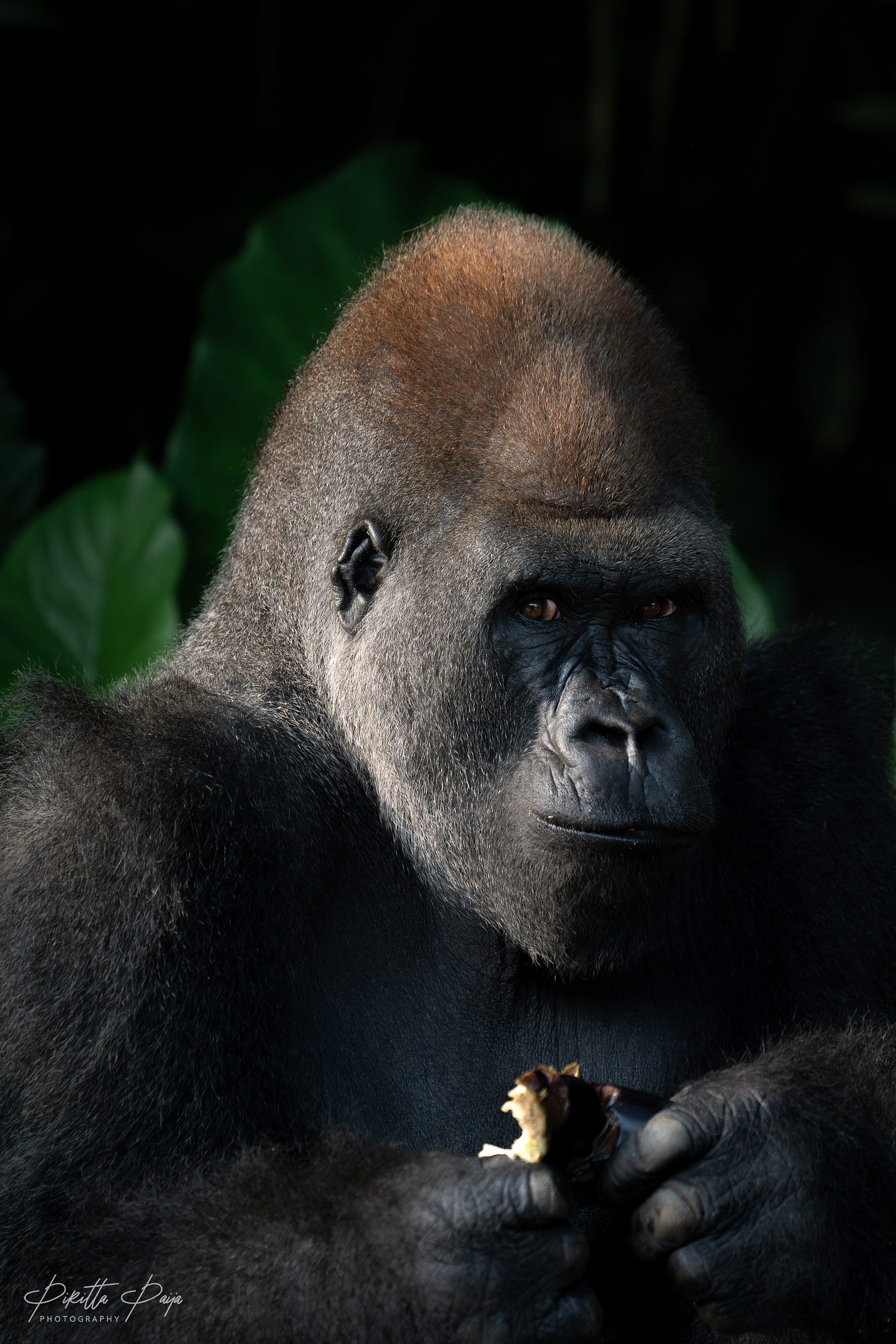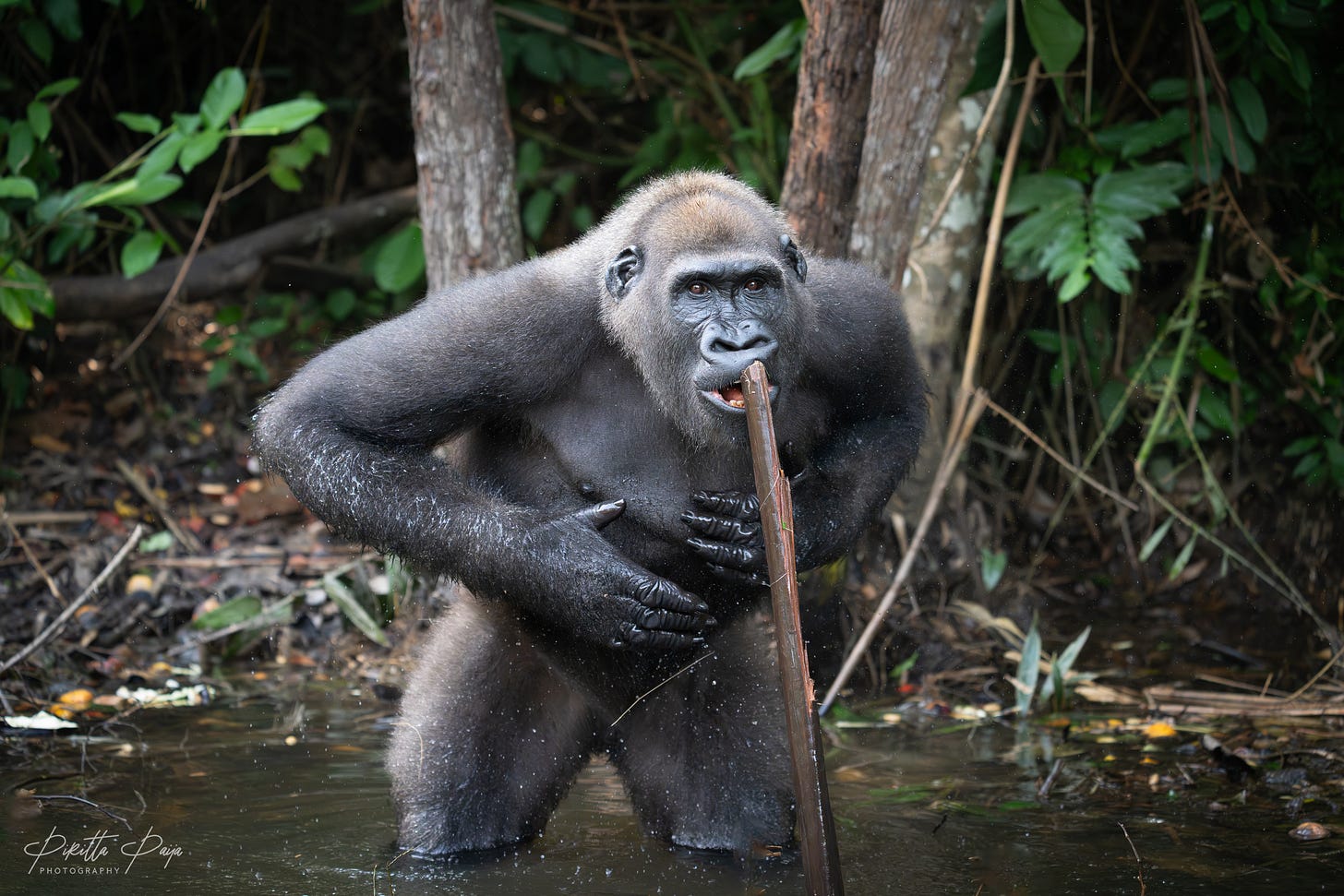The Western Lowland Gorillas of Camp Abio in the Republic of Congo 🇨🇬
Finally meeting our first western lowland gorillas was a memorable experience, even though they were “only” semi-wild, living in an isolated area.
Initially, we hesitated a bit about whether to go here or not. We had heard only praising reviews from other overlanders we had met, but we still stayed a bit critical. The gorillas here are only semi-wild, after all. They live on isolated islands and were initially brought here from the London Zoo. Therefore, they can never be habituated entirely back into the wild, as they couldn’t survive 100% independently.
They are regularly fed various fruits, so they remain very accustomed to humans. Additionally, the tour is not cheap; it costs 60,000 CFA (approximately 90€) per person. Then again, this place was the only one in the Republic of Congo where it’s 100% guaranteed to see the western lowland gorillas. So, eventually, we decided to go.
And in the end, we didn’t regret it – on the contrary.
Getting to Camp Abio in the Republic of Congo
We left Brazzaville, from where there were about 143 kilometers of good tar road to the turnoff to Camp Abio. From there, you turn to the less than 14 km long dirt track into the bush. Our OSMand Maps showed the track without troubles. There were only a few “alternate” tracks crisscrossing along, as some of them were muddier than others, but it was easy to choose where to drive.
This track was relatively short but scenic, a bit muddy, and, on some parts, sandy, but as it was still the end of the dry season, it wasn’t difficult at all. A few parts were a bit deeper mud or sand, but mostly easygoing without any low-range stuff.
When we got to Camp Abio, the place seemed a bit rundown, with houses that had seen better days. However, the kitchen had a gas stove and some sofas to sit on. The Internet was non-existent, so it was a forced and healthy time spent offline. We were the only visitors when we got there. There wasn’t any “proper” camping area, we just parked in an empty place near the kitchen. The following morning, we noticed that we had parked almost in the middle of a bustling ant highway, which wasn’t a pleasant surprise. However, they were gone relatively quickly and did not invade our car.
The camp staff was generally friendly, but the manager’s customer service skills fell short. She seemed to get very frustrated with all our detailed questions and inquiries about the tour. There was “a big group” coming the next day, and we didn’t want to join it, but arranging a more private tour seemed difficult. Also, she couldn’t tell how long the tour would actually be, among other things. It’s amusing how simple things can sometimes become so complicated, without a valid reason.
Amidst our discussions, we suddenly heard that a large truck was approaching the camp. It was a big MAN truck with a nice German couple and a lovely three-legged pug (!) on their way south (check out @kollers.on.tour on Instagram!). Together with them, after more negotiations with the manager, we eventually managed to arrange a tour for the four of us at 7:30 a.m. the next morning.



Meeting Our First Western Lowland Gorillas
All four of us were ready at 7:30 a.m. sharp and eager to go. Our guide spoke only French, as did the rest of the camp staff, so Niina, being the only one of us with some French skills, was the translator. We all fit nicely in the boat with enough space, but we wondered how it could ever fit more than four people. That would be uncomfortable, for sure.
The first gorilla lived only about a 15-minute boat ride away. He was an older, large male with a distinctive face and a wide range of expressions. When he heard the boat’s motor approaching, he immediately appeared behind the trees to welcome the fruits thrown to him. Our guide had brought two large buckets full of various fruits with us, including bananas, avocados, aubergines, and mangoes, and started throwing them to him.
Sometimes he would bring our boat only a few meters away from this giant, yet somehow gentle-looking, gorilla. He was accustomed to being this close to humans, but sometimes I felt we were a bit too close for comfort. However, I could do nothing but rely on our guide and his expertise. We still had surprisingly good opportunities to take lovely photos and videos of him, and enjoyed his company for a long time.

With a 100-400mm lens, I concentrated more on portraits, like the one above, but I still managed to capture a few “animal in landscape” shots as well. The light started to get harsh pretty early on, but luckily, the many trees provided some ample shadows to contrast the scene. I could also suggest taking a smaller lens with you, like a 24-105mm or 24-70mm, for example. I only have one camera body and opted not to change lenses on the boat this time.
After about an hour, it was time to say goodbye to this big guy and head on to the other gorillas on the small delta. The journey was a bit longer than we had thought, but a nice one through many narrow channels and mangroves. Somehow, it reminded us a bit of a boat tour we once did to see the pink dolphins in the Amazon, even though the scenery was totally different.
Finally, we cornered a small and narrow channel that ended in a dead end. Two lowland gorillas—a male and a female—were sitting on the shore.
The female one soon turned out to be a true rascal and entertainer. She played with sticks, drummed her chest, rolled over, splashed the water at us, swung and climbed on the trees, to name a few of her tricks. The male just sat on the shore and looked on, sometimes like a father watches a child play, but secretly rolling his eyes at the foolish girl.
But we had so much fun watching her show off and play! We also got many cool photos and videos. It seemed that both of them were more interested in us than in the fruits they got.
Below is a short video of our visit to Camp Abio in late March 2025. Enjoy the gorillas!
You can also subscribe to our YouTube Channel here!
At least another hour flew past, and when all the fruits were gone and the gorillas slowly retreated into the bush, our guide asked if we were ready to go. A bit reluctantly but extremely satisfied with what we had just experienced, we said our goodbyes to the gorillas.
Kudos to our guide, who never urged us to leave but instead gave us all the time we wanted with the gorillas. That resulted in a complete and rich experience with plenty of great photographing and observing opportunities.
On our way back to Camp Abio, we also saw a glimpse of a hippo in the river! Our travel companions hadn’t seen one in nature yet, so they got very excited. And we were pleased to see one again, as we had already almost grown to miss their grunting noises in the evening and night.
Sadly, the Western Coast of Africa is not as wildlife-rich as the Southern and Eastern parts of Africa. Here in the West, animals are more confined to specific areas and smaller patches of land, whereas in the South and East, they are more widely distributed, and you can see them almost everywhere.
They say that the West Coast of Africa is more about culture and people than wildlife, so we’ll cherish all these sparse but extraordinary wildlife encounters on the way!
After more than half an hour’s windy and speedy boat ride, we docked the boat back at the camp, and we had been away for almost three hours (double the time the camp manager had mentioned initially). The next guests were already eagerly waiting at the shore to go. However, there were only two people, so we secretly wondered where the “big group” mentioned was.
It seemed we received a longer tour than usual and were very happy about it. Maybe, it sometimes pays off to be a bit of a “harder customer”, who knows. ;)
After returning, we ate some more breakfast and then left to drive towards the north. We had already decided to visit the amazing Odzala-Kokoua National Park and wanted to be on our way, as the park was more than 500 kilometers away.
While having our breakfast at the camp, the sky had turned grey, and we anticipated rain. All the years we’ve spent around Africa have taught us well how to observe the sky ahead of rain. You can also definitely smell it in the air.
Then, while we were already driving on the small dirt track back to the main road, a full-on rainstorm broke out, and it felt like it was suddenly raining cats and dogs from the sky. How lucky we had been, as the whole morning had been dry and sunny!
A fellow overlander Defender drove past us on the track on their way to the camp, but unfortunately, stopping for a small chat didn’t tempt either of us in the heavy downpour, so we just waved and made the traditional Defender greetings. Hopefully, those guys had a good time, too, despite the current weather.

Is Camp Abio Worth a Visit?
Was this a good experience, in the end? Yes, definitely! And yes, we can also recommend seeing the western lowland gorillas here.
It is a trustworthy project with a long-standing reputation and is worth your support. We conducted our background research before deciding to go, and their good reputation was also one of the reasons we chose to go.
It’s a bit expensive, but then again, so are most national parks in Africa, and this opportunity to see the western lowland gorillas is truly unique. Don’t waste this chance when you are in the Republic of Congo! It’ll be worth it.
Hopefully, you’ll also have the chance to see them someday.
We then headed towards the Odzala-Kokoua National Park, where we hoped to see more western lowland gorillas, this time in their completely wild state. Did we succeed in seeing them and some other new animals?
Read the next chapter, too, and discover what happened in Odzala-Kokoua!
Stay Wild & Adventurous,








